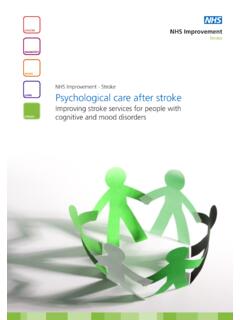Transcription of NICE impact cardiovascular disease prevention
1 cardiovascular disease prevention2 nice impact cardiovascular disease preventionAround 7 million people in the UK are affected by cardiovascular disease (CVD). This report considers how nice s evidence-based guidance can contribute to improvements in the prevention of CVD. Changing behaviour to reduce risk p4 Focusing on behaviour change can reduce the incidence of CVD and, in turn, help to prevent other major causes of death and illness. We have looked at how nice recommendations on obesity, smoking and physical activity can help reduce CVD risk at the population and individual level. Diagnosing and managing 6 high-risk conditions p6 NHS RightCare has identified 6 high-risk conditions which are major causes of CVD events such as heart attack and stroke. We have reviewed how nice recommendations are used to identify and manage high blood pressure (p7), high cholesterol (p8), atrial fibrillation (p11), chronic kidney disease (p13), high blood sugar (pre-diabetes) (p14) and diabetes (p15) to reduce CVD risk.
2 We have also looked at how nice and our partners in the system are working together to put these recommendations into practice. Spotlight on severe mental illness p17 Severe mental illness is also linked with an increase in CVD risk. We have considered how nice recommendations can contribute to improving the physical health of people with severe mental illness. Commentary p18 Jamie Waterall reviews recent achievements and considers nice s role in contributing to improvements in the prevention of report highlights progress made by the healthcare system in implementing nice guidance. We recognise that change can sometimes be challenging, and may require additional resources such as training, new equipment or pathway reconfiguration. We work with partners including NHS England and NHS Improvement to support these changes, and we also look for opportunities to make savings by reducing ineffective cardiovascular disease preventionWhy focus on CVD prevention ?
3 nice impact reports review how nice recommendations for evidence-based and cost-effective care are being used in priority areas of the health and care system, helping to improve outcomes where this is needed provides evidence-based guidance and advice to help improve health and social care services. The uptake of nice guidance is influenced by close relationships with partners in the system, such as NHS England and Public Health England (PHE). Next steps on the NHS Five Year Forward View was commissioned by NHS England to set out a series of practical and realistic steps to deliver a better, more joined-up and more responsive NHS. A particular focus of the report is prevention . Next Steps on the Five Year Forward View highlights that CVD is highly preventable through evidence-based treatments for high risk conditions. NHS RightCare and PHE have established a CVD prevention pathway and so, in this report, we have focused on what we know about the uptake and impact of our recommendations in this published its first CVD guideline, on hypertension, in 2004.
4 Since then we have produced a suite of guidance and advice on the diagnosis and management of cardiovascular conditions such as acute coronary syndromes, heart failure, and venous thromboembolism. However, because the focus of this report is CVD prevention , we have looked at a broad range of nice guidance on conditions that increase the risk of CVD, such as diabetes, and risk factors that can be altered, such as obesity. We routinely collect data which give us information about the uptake of our guidance. To produce this report, we have worked with national partners to select data which tell us how nice guidance can make a difference in priority areas of CVD prevention . The data also highlight areas where there remains room for is a general term for conditions affecting the heart or blood vessels. It s usually associated with a build-up of fatty deposits inside the arteries (known as atherosclerosis) and an increased risk of blood clots.
5 It can also be associated with damage to arteries in organs such as the brain, heart, kidneys and eyes. Heart disease and stroke are the most common forms of CVD. Other forms include a mini-stroke (transient ischaemic attack or TIA) and peripheral arterial disease (narrowing of the arteries, usually in the legs).26% 26% of all deaths in the UK are caused by CVD4 nice impact cardiovascular disease preventionChanging behaviour to reduce riskPoor diet, physical inactivity and smoking are risk factors for CVD. Behaviour change at the population and individual level can reduce the incidence of June 2010, nice published a guideline on CVD prevention , covering the main risk factors linked with cardiovascular disease such as poor diet, physical inactivity and smoking. It aims to reduce the high incidence of CVD through interventions at the population level. It is complemented and supported by a range of nice guidance recommending interventions focused on changing individual behaviour.
6 In this section of the report we have looked at the uptake and impact of some of these recommendations. SmokingQuitting smoking is described by the British Heart Foundation (BHF) as the single best thing you can do for your heart health. nice s first public health guideline was on smoking: brief intervention and referrals, published in 2006. We have since published a range of guidance and advice on smoking and tobacco, aiming to prevent people from taking up smoking, reduce harm and help people quit. Data from the Public Health Outcomes Framework (PHOF) show the proportion of people who smoke in England continues to reduce each year; of adults smoked in 2016, down from in 2012. The nice guideline on smoking prevention in schools aims to prevent children and young people under 19 from taking up smoking. In 2016, NHS Digital published a report on smoking, drinking and drug use among young people in England which found that 19% of children aged 11 to 15 had tried smoking at least once, down from 23% in 2012.
7 Nearly all schools reported providing pupils with lessons about smoking, as recommended by nice . However only 60% of pupils recalled a lesson on smoking in the last year and only 59% of pupils felt they received enough information about smoking. Percentage of children aged 11 to 15 who have tried smoking at least once23% 2012 19 % 2016 nice s guidance on CVD prevention at the population level is complemented by a suite of guidance recommending interventions to help people stop smoking, eat a better diet and increase their physical activity. The proportion of people who smoke continues to reduce, but data suggest that more could be done to implement nice s recommendations on preventing smoking in schools and in secondary care settings. There is wide regional variation in the proportion of people who are overweight or obese and more than 1 in 5 adults report getting less than 30 minutes of moderate intensity activity each week. These data suggest that more could be done to help people manage their weight and get physically active.
8 5 nice impact cardiovascular disease preventionNICE s guideline on smoking in acute, maternity and mental health services promotes smokefree policies and recommends how to help people stop or abstain from smoking in these settings. In 2016, the British Thoracic Society carried out a smoking cessation audit of nearly 15,000 inpatients which gave us information about the uptake of these recommendations. nice recommends that everyone who comes into contact with a healthcare professional should have their smoking status recorded and, if they are a smoker, be offered advice on how to quit. The audit found that, although smoking status was recorded in 73% of inpatient records, only 28% of current smokers were asked if they d like to quit. Of these, just 20% were referred to a hospital smoking cessation service. Diet and obesityPoor diet and obesity also increase the risk of CVD. nice published a guideline on obesity prevention in 2006 and since then we have published a suite of guidance and advice on diet, nutrition and obesity.
9 The guidance aims to prevent children, young people and adults from becoming overweight or obese. It also covers identifying, assessing and managing obesity, and referral to lifestyle services. The PHOF records the proportion of people who are overweight or obese in England. In 2016/17, 23% of children aged 4 to 5 were classed as overweight or obese and, in 2015/16, 61% of adults were overweight or obese according to their BMI. However, there is wide regional variation in these rates. In children aged 4 to 5, the percentage classed as overweight or obese ranged from 15% to 28% in CCGs across England, and the range for adults is even wider. Physical activityBeing active also helps reduce the risk of CVD and nice has produced a suite of guidance aimed at increasing physical activity. PHE s indicators show that 22% of adults in England report getting less than 30 minutes of moderate intensity physical activity each week. nice s guideline on walking and cycling aims to help people achieve recommended physical activity levels.
10 PHE s indicators show that only around half the adults in England say they walk at least 5 times a week for 10 minutes or more. These data suggest that there is room for improvement in many people s activity levels. Prostate cancerLowest CCG England average52%92 Highest CCG 60%60%52%38%Graphic [perhaps something like proportionally sized circles or 3 38%050100 Lowest CCG 43% England average 61%Highest CCG 73%52% Chart in left-hand column: Percentage of women who smoke at the time of delivery, 2016/17 Highest local authority England average Lowest local authority of adults classed as overweight or obese in England, 2015/166 nice impact cardiovascular disease preventionDiagnosing and managing 6 high-risk conditionsHigh blood pressure, high cholesterol, atrial fibrillation, chronic kidney disease , high blood sugar (pre-diabetes) and diabetes are major causes of CVD events such as heart attack and stroke. Late diagnosis and under-treatment is analysis by PHE suggests that there is an opportunity to prevent more than 9,000 heart attacks and at least 14,000 strokes over the next 3 years with better diagnosis and management of high blood pressure, high cholesterol and atrial fibrillation.]










